It’s no secret our family loves pancakes. There’s a reason I’ve shared so many of our favorite pancake recipes on my blog! From einkorn flour Greek yogurt pancakes and banana bread protein pancakes to egg white and oatmeal protein pancakes or Greek yogurt pancakes, we make some version of pancakes in our house every single week. But our favorite pancakes? The pancakes that feel the most special? The pancakes that make every single person in our house light up when they hear we’re having them for breakfast? German pancakes. Without a doubt.
German pancakes were our family’s “special occasion” pancakes when I was growing up. Whether my mom would whip up a batch of German pancakes on one of our birthdays or on Easter morning or Christmas Eve, we knew when German pancakes made their way onto the breakfast table, it was a special day.
The Best Homemade German Pancakes Recipe
Fast forward several decades (yes, decades, wow I feel old), and now I love making these pancakes for my kids. However, now that I’m a mom my perspective on why I love these pancakes so much has slightly shifted. Yes, they’re still wonderfully delicious and satiating (thanks to lots of eggs in the batter), but they’re also ridiculously EASY to make.
There’s no hovering over a griddle as you flip pancake after pancake. All the ingredients combine easily in a blender and dishes/clean-up is minimal. German pancakes are also the perfect recipe to have on hand when you have guests in town because they’re made in a single baking dish and don’t require too much time in the kitchen. Plus, they feel kind of fancy!
Our boys genuinely enjoy helping me make German pancakes but their absolute favorite part is checking the oven as the pancake batter bakes because it puffs up into a magical poof of pancake happiness. (Trust me, when you’re 4-years-old, this really is magic.)
How to Make German Pancakes
If you’ve never made German pancakes before you’re in luck because I’m walking you through exactly how to make German pancakes today. Spoiler alert: They’re pretty different from standard American pancakes. They come together in a bowl or blender and bake in the oven, eliminating the need to hover over a griddle or stovetop. One of the easiest breakfasts ever, they’re ready in about 20 minutes and are very hard to mess up, so they’re a great recipe to encourage your kids to help with if they want to be involved in the kitchen.
What Is A German Pancake?
German pancakes, also known as Dutch baby pancakes, are a type of pancake made with eggs, milk, flour, and vanilla. They’re typically served for breakfast and, unlike American pancakes, which cook in a pan on the stove or on a griddle, German pancakes bake in pan (often a cast iron pan, if you have one) in the oven. As a result, they puff up as they bake and fall as they cook, which results in a slightly eggier, less fluffy texture than regular pancakes. (I think they’re closer in taste to a thicker crepe than a fluffy pancake.)
German Pancake Recipe
Ingredients
To make this easy German pancakes recipe, you’ll need the following ingredients:
- Butter: This coats the pan, preventing the pancake batter from sticking and adds a wonderfully rich flavor. I’ve used both salted and unsalted butter and both work well. There is NO substitute for butter in this recipe, as its impact on flavor cannot be beat! Embrace the butter!!
- Eggs: Yep, there are a LOT of eggs in this recipe which I love because I think it makes the more filling than standard American pancakes. The eggs also contribute to the rich flavor and provide structure, helping the pancake hold its shape.
- All-purpose flour: This forms the base of the batter. If needed, you may also substitute a 1:1 all-purpose gluten-free flour to keep this recipe gluten-free.
- Whole milk: I highly recommend using whole milk in this recipe for the richest taste. However, you may substitute a low-fat milk, dairy-free milk or a plant-based alternative.
- Vanilla: Use high-quality pure vanilla extract to add a delicious vanilla flavor throughout the batter.
- Salt: Just a pinch helps enhance the flavor of the rest of the ingredients.
- Lemon juice: The acidity complements the rich, sweet flavor of the pancake and adds a delicious tang. Freshly squeezed is best!
- Powdered sugar (confectioners sugar): The perfect finishing touch, this adds a delicious sweetness to the dish and is a MUST if you ask my kids… and me. The batter itself does not have any sugar, so powdered sugar adds a wonderful touch of sweetness.
Instructions
Step 1
Preheat the oven to 425 degrees. Then, add butter to a 9×13 baking dish, and put it in the oven to melt as the oven preheats.
Step 2
In a high-powered blender, add the eggs, flour, milk, vanilla, and a pinch of salt, and blend until smooth. Once the oven is preheated and the butter in the baking dish is completely melted, remove the dish from the oven.
Then, pour the pancake batter into the dish. Don’t mess with the batter once you pour it into the pan! (You want little pools of melted butter to come up over the sides!)
Step 3
Bake for 20-25 minutes or until the pancake is very puffy. The edges should be golden brown.
Step 4
Remove the baking dish from the oven, and top the pancakes with a squeeze of lemon juice and a sprinkle of powdered sugar. Add any additional toppings (we love fresh berries), and enjoy!
German Pancakes Recipe

German Pancakes
- Prep Time: 5 minutes
- Cook Time: 20 minutes
- Total Time: 25 minutes
- Yield: 6 servings 1x
- Category: breakfast
- Method: oven
Description
German pancakes are wonderfully delicious, magically poofy (kids love to watch them bake!) and satiating (thanks to lots of eggs in the batter), but they’re also ridiculously easy to make. Worthy of a special occasion or a simple, cozy Sunday morning at home, they’re a recipe they feels fancy but could not be any easier to whip up at the last minute!
Ingredients
- 1/4 cup butter
- 6 eggs
- 1 cup all-purpose flour
- 1 cup whole milk
- 1 teaspoon vanilla
- Dash of salt
- Squeeze of lemon juice
- Powdered sugar
- Preferred toppings: We love maple syrup and fresh berries
Instructions
- Preheat oven to 425 degrees. Add butter to a 9×13 baking dish and put into the oven to melt as the oven preheats.
- In a high-powered blender, blend eggs, flour, milk, vanilla and salt until completely smooth. Once oven is preheated and butter is melted, remove the baking dish from the oven and pour pancake batter into baking dish.
- Bake in the oven for 20-25 minutes, or until very puffy. The edges of the pancake should be slightly browned and golden.
- Remove from the oven and top with a squeeze of lemon juice and a sprinkle of powdered sugar.
- Add additional toppings (we love maple syrup and fresh berries) and enjoy!
Nutrition
- Serving Size: 6 servings
- Calories: 240
- Sugar: 2g
- Sodium: 175mg
- Fat: 14g
- Saturated Fat: 7g
- Carbohydrates: 17g
- Fiber: 1g
- Protein: 10g
How to Store
German pancakes are best served right away while they’re still warm. However, if you have leftovers, you can transfer them to an airtight container or sealable bag, and store them in the refrigerator for up to 3 days.
If you want to freeze the pancakes, transfer leftover (completely cooled!) pancakes to a freezer-safe bag, place a sheet of parchment paper between each piece, and freeze them for up to 2 months. Thaw in the fridge overnight before serving. When you’re ready to eat, warm leftovers in a skillet over medium heat on the stove. Or, if you’re in a hurry, you may also reheat them in the microwave.
FAQs
What toppings can I add?
Feel free to add any toppings you typically use on pancakes to your German pancakes. Some of my favorite options include maple syrup, fresh berries, coconut flakes, chopped nuts, orange marmalade and a dollop of whipped cream. (I’ve also tried a peanut butter drizzle and chocolate chips and that combination is amazinggg for a more dessert-like option.) My kids are all about powdered sugar, fresh berries and maple syrup.
What’s the difference between German pancakes and regular pancakes?
There are several differences between German pancakes and regular or American pancakes. German pancakes are cooked in the oven while regular pancakes cook on the stove or on a griddle. In addition, German pancakes are made with more eggs and do not contain any leaveners such as baking soda or baking powder. As a result, though German pancakes are thin, they have a denser, eggier texture with slightly crispy edges while typical pancakes are fluffier with a softer texture throughout.
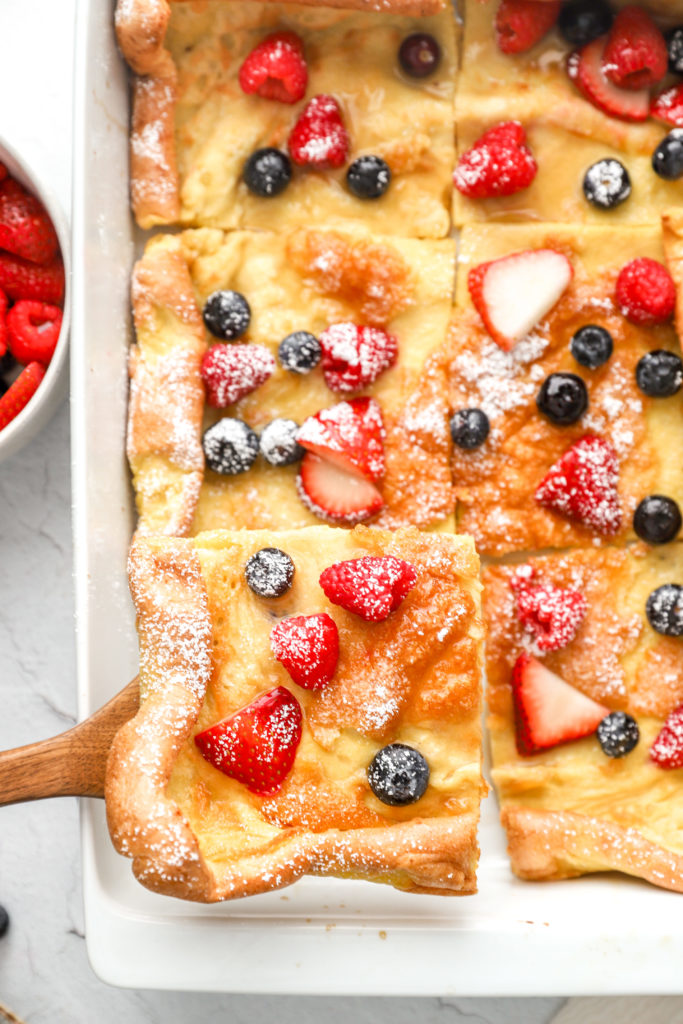
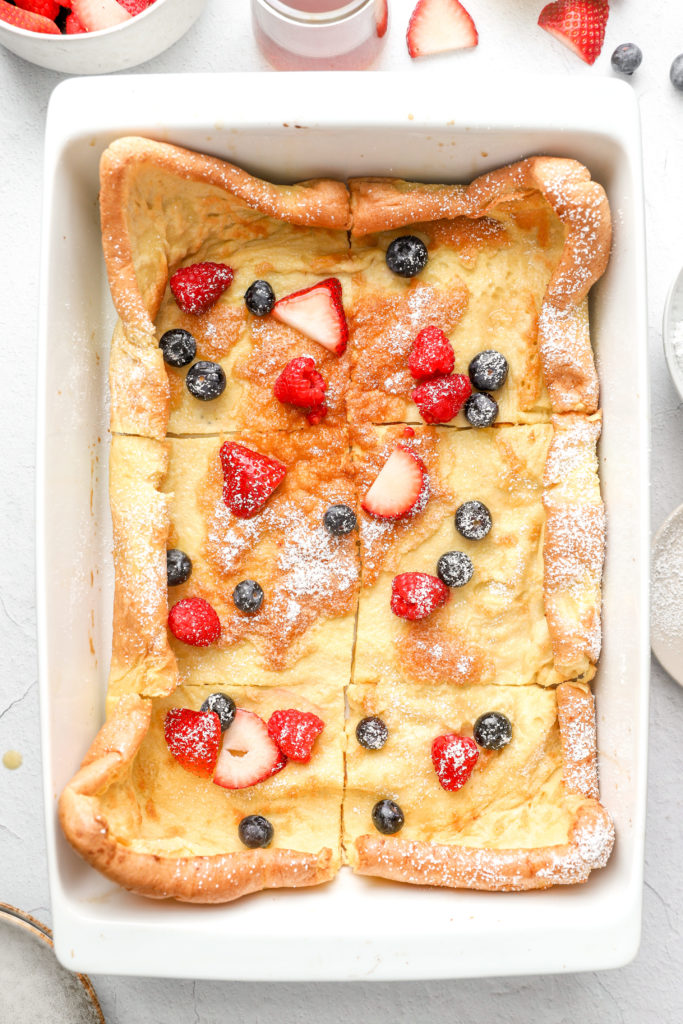
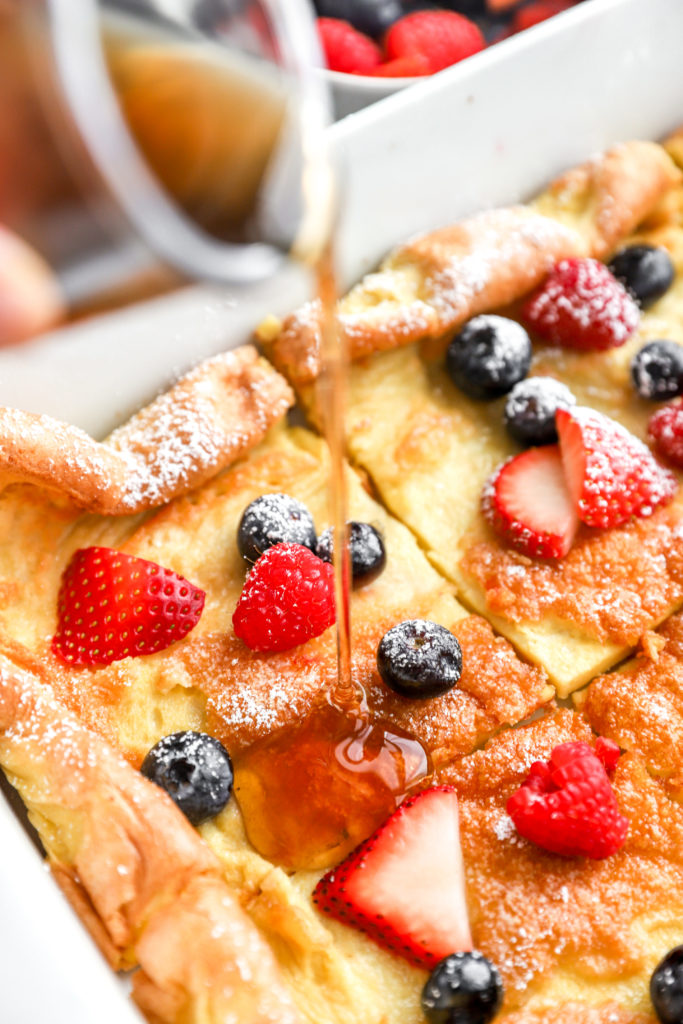
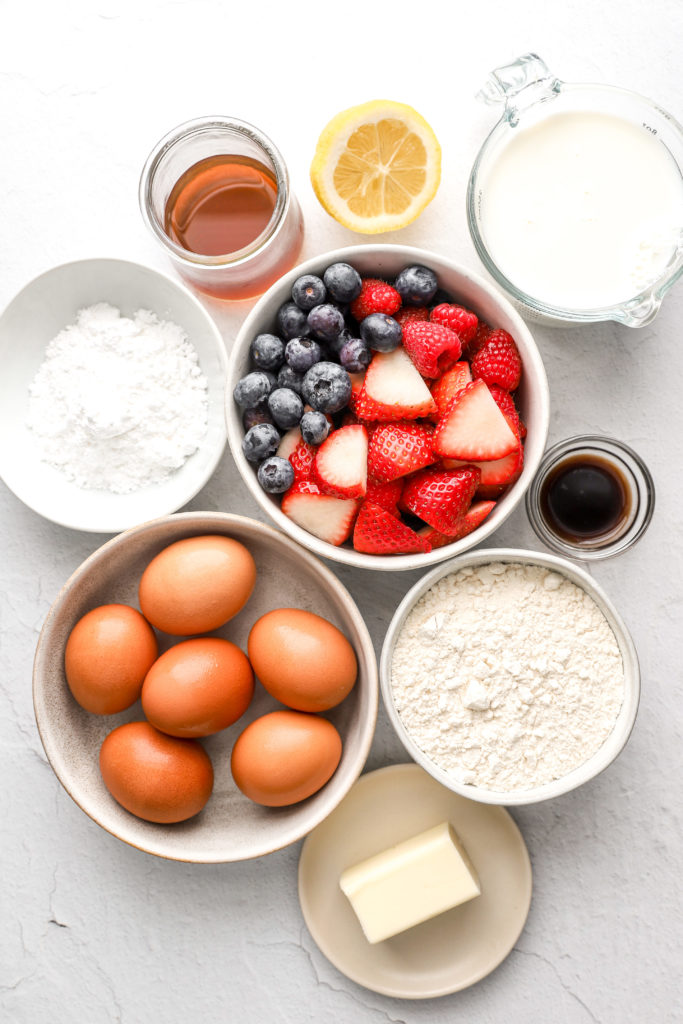
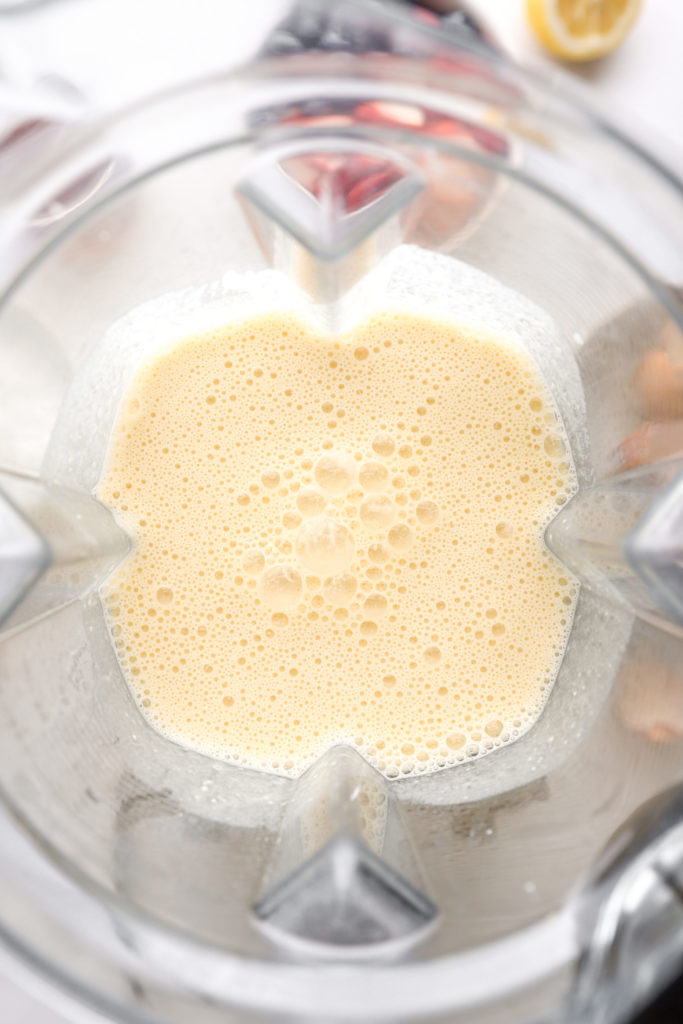
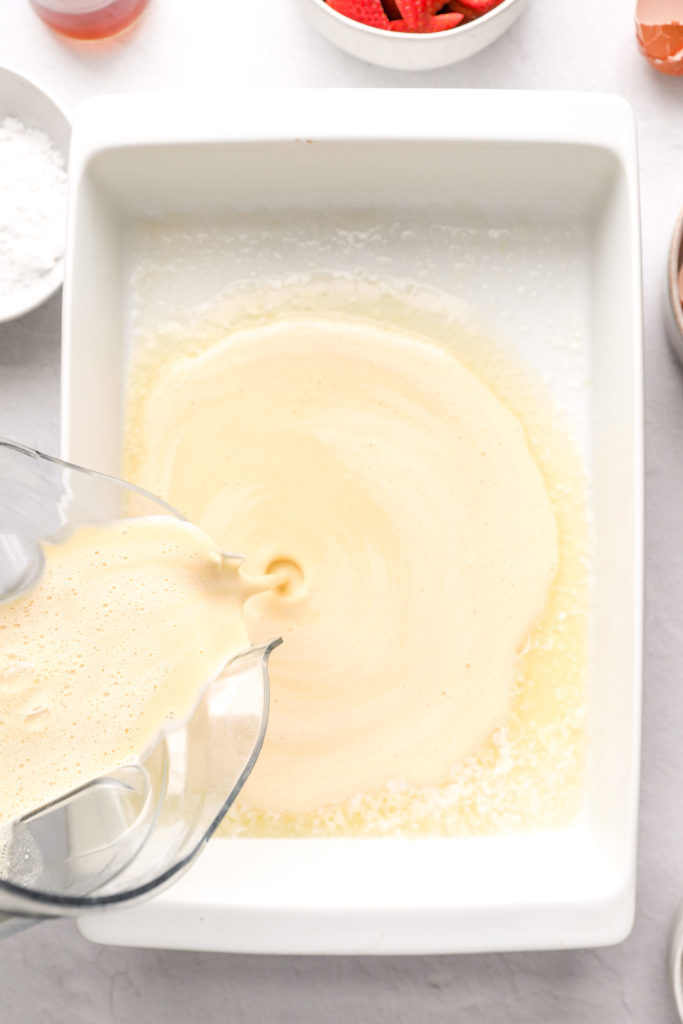
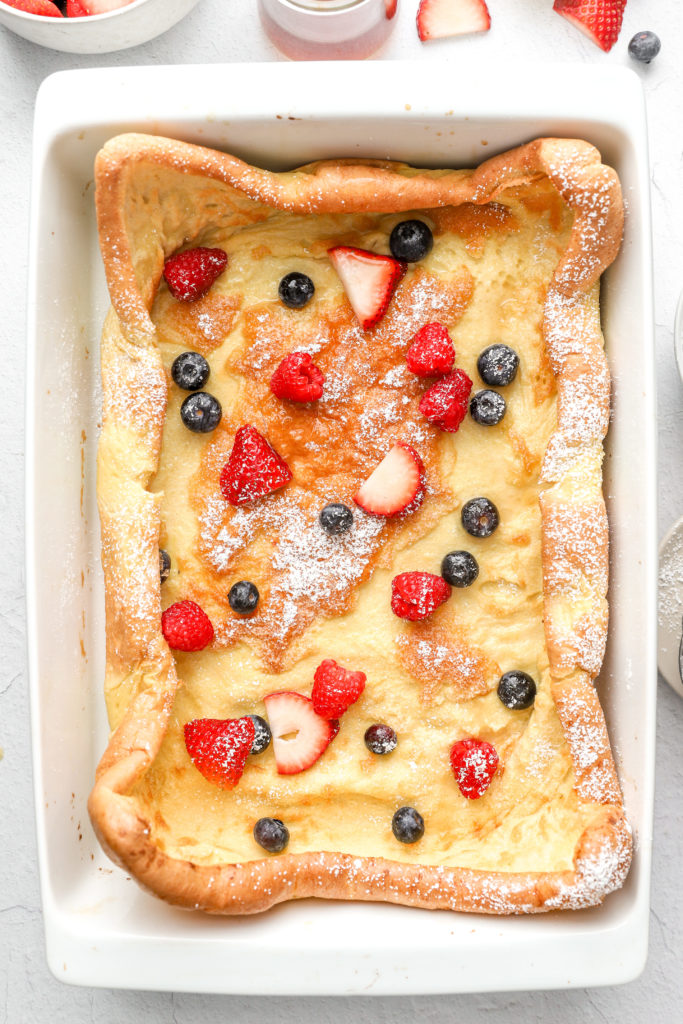
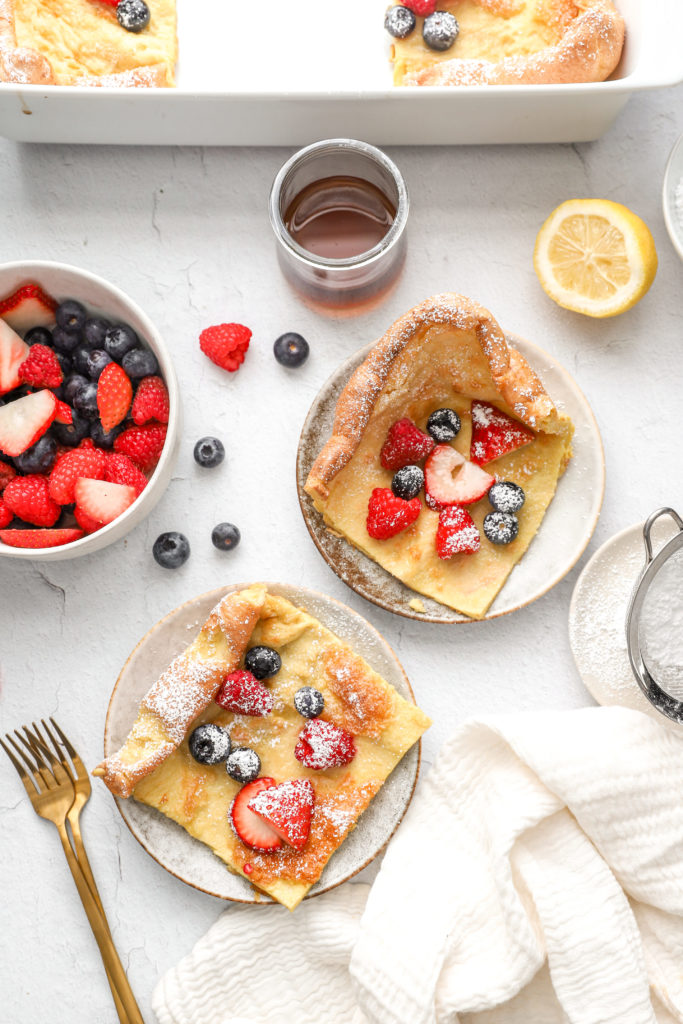
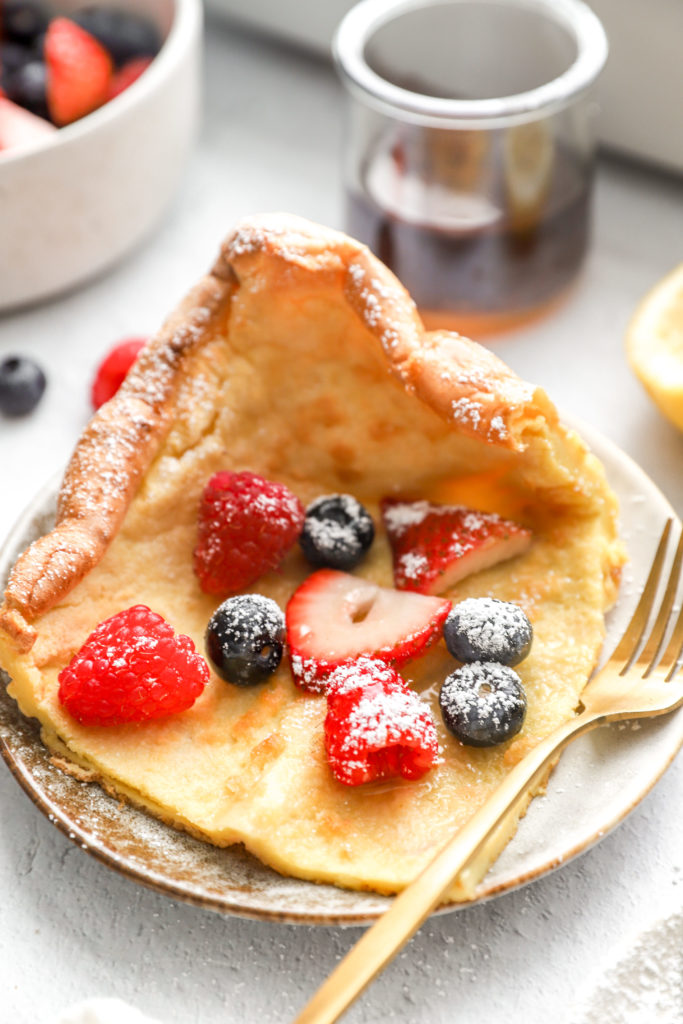
Love this!!! I am going to try and make next week while I am off. I have a 1 year old and am looking to start new traditions for our immediate family. I love that this recipe is simple yet looks delicious, so I can focus more on being with my little one. Can’t wait to try this. Thanks for sharing!!
I hope you all love the recipe and have fun making it together!!!
I wonder why they are called German pancakes? Maybe the Amish started making them that way? – traditional German pancakes made in Germany are made in a skillet and rarely eaten for breakfast.
I definitely prefer American pancakes, but my kids like both.
„German chocolate cake“ is also not really a German thing either 😅 but people here like it when i make it.
– From an American who married a German and has been in Germany for over 20 years
Made this recipe this morning for Christmas. It was so much easier than making pancakes on the stovetop with lots of littles running around. The taste reminded me more of a crepe, albeit thicker. We topped with guava marmalade, and it was so good. Thanks for sharing!
Thank you for trying this recipe and for leaving such a kind review, Jessica!! I’m so so glad you like them!!!